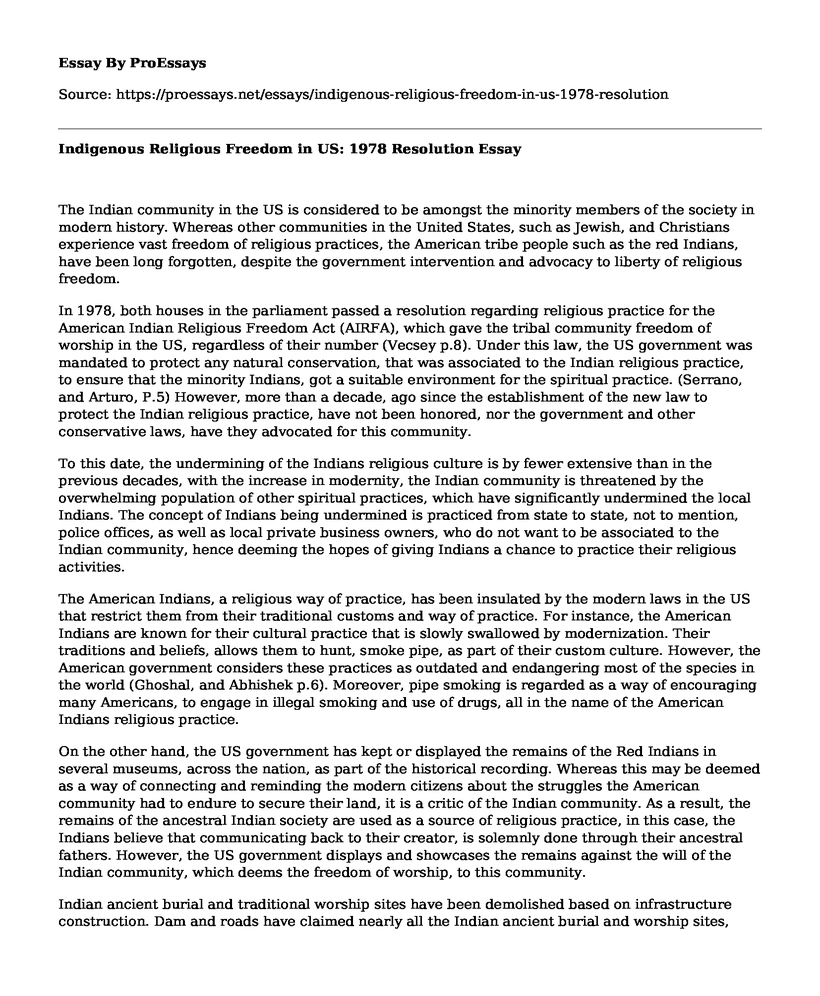The Indian community in the US is considered to be amongst the minority members of the society in modern history. Whereas other communities in the United States, such as Jewish, and Christians experience vast freedom of religious practices, the American tribe people such as the red Indians, have been long forgotten, despite the government intervention and advocacy to liberty of religious freedom.
In 1978, both houses in the parliament passed a resolution regarding religious practice for the American Indian Religious Freedom Act (AIRFA), which gave the tribal community freedom of worship in the US, regardless of their number (Vecsey p.8). Under this law, the US government was mandated to protect any natural conservation, that was associated to the Indian religious practice, to ensure that the minority Indians, got a suitable environment for the spiritual practice. (Serrano, and Arturo, P.5) However, more than a decade, ago since the establishment of the new law to protect the Indian religious practice, have not been honored, nor the government and other conservative laws, have they advocated for this community.
To this date, the undermining of the Indians religious culture is by fewer extensive than in the previous decades, with the increase in modernity, the Indian community is threatened by the overwhelming population of other spiritual practices, which have significantly undermined the local Indians. The concept of Indians being undermined is practiced from state to state, not to mention, police offices, as well as local private business owners, who do not want to be associated to the Indian community, hence deeming the hopes of giving Indians a chance to practice their religious activities.
The American Indians, a religious way of practice, has been insulated by the modern laws in the US that restrict them from their traditional customs and way of practice. For instance, the American Indians are known for their cultural practice that is slowly swallowed by modernization. Their traditions and beliefs, allows them to hunt, smoke pipe, as part of their custom culture. However, the American government considers these practices as outdated and endangering most of the species in the world (Ghoshal, and Abhishek p.6). Moreover, pipe smoking is regarded as a way of encouraging many Americans, to engage in illegal smoking and use of drugs, all in the name of the American Indians religious practice.
On the other hand, the US government has kept or displayed the remains of the Red Indians in several museums, across the nation, as part of the historical recording. Whereas this may be deemed as a way of connecting and reminding the modern citizens about the struggles the American community had to endure to secure their land, it is a critic of the Indian community. As a result, the remains of the ancestral Indian society are used as a source of religious practice, in this case, the Indians believe that communicating back to their creator, is solemnly done through their ancestral fathers. However, the US government displays and showcases the remains against the will of the Indian community, which deems the freedom of worship, to this community.
Indian ancient burial and traditional worship sites have been demolished based on infrastructure construction. Dam and roads have claimed nearly all the Indian ancient burial and worship sites, undermining the religious practices of the Indian community. Through this, it is clear that the 1978 (AIRFA) act is not considered to be functional, as the Indian population is stripped off, from their rightful access to their freedom of religious practice.
Work cited
Ghoshal, Abhishek, et al. "Assessing changes in the distribution of the Endangered snow leopard Panthera uncia and its wild prey over two decades in the Indian Himalaya through interview-based occupancy surveys." Oryx (2017): 1-13. DOI: https://doi.org/10.1017/S0030605317001107Serrano, Arturo, et al. "Is the West Indian mana-tee (T Trichechus manatus) at the brink of extinction in the state of Veracruz, Mexico." Aquatic Mammals 43.2 (2017): 201-207. DOI 10.1578/AM.43.2.2017.201
Vecsey, Christopher, ed. Handbook of American Indian religious freedom. New York: Crossroad, 1991.
Cite this page
Indigenous Religious Freedom in US: 1978 Resolution. (2023, Jan 16). Retrieved from https://proessays.net/essays/indigenous-religious-freedom-in-us-1978-resolution
If you are the original author of this essay and no longer wish to have it published on the ProEssays website, please click below to request its removal:
- How Does Mark Use His Skill as a Storyteller To Present Jesus as a Savior?
- History of Christianity in Hui Research
- Literary Analysis Essay on The Indian Country
- John Wesley: Reviving Christianity in the 18th Century - Essay Sample
- Free Essay Example on Migrant Latino Families in the US: Cultural Acculturation of Puberty Practices
- God's Gift: Unifying Christians Through Jesus Christ - Paper Sample
- Status of Women in Hinduism - Essay Sample







